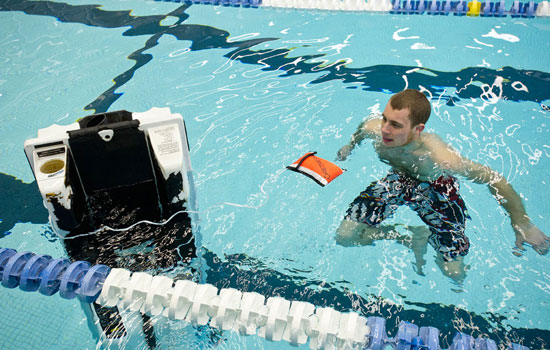RIT student invents way to locate sunken vehicles
Personal watercraft users could save time and money
A. Sue Weisler
Jordan Darling brings his Jet Ski into the RIT pool to demonstrate the Retriever, a beacon to help locate a submerged personal watercraft. The bright pouch floats above the water and is connected to the vehicle with a 50-foot rope and can save thousands in search and retrieval costs.
When Jordan Darling’s new, custom-made personal watercraft experienced engine trouble in Lake Ontario last summer, it sunk in eight feet of water about 200 feet from shore.
It took him, his family, friends and sheriff’s deputies five days searching the water to recover the vessel. Darling found it after spending $500 to rent a helicopter for an aerial search. “You couldn’t see it. The water was so murky,” he says.
Not only did he want to get his $6,000 Jet Ski back, he could have faced a $1,000-a-day fine for having a vehicle in the water. Any leaking gas or oil from its engine could pose an environmental hazard.
The frustrating episode sparked Darling, a third-year mechanical engineering technology major from Oswego, N.Y., to continue work on a prototype he had made on a personal buoy that could have helped him find his Jet Ski.
His patent-pending concept is fairly simple: “Retriever,” which comes in neon yellow or orange, is a pouch with a 50-foot polypropylene rope coiled inside. The end of the rope is connected to the vehicle and the pouch is secured with Velcro.
Should the vehicle start sinking, the operator can detach the device and deploy it, leaving the marker floating on top of the water to make retrieval easier.
“When you know you’re in trouble and your vehicle is going down, at that moment you can deploy the system and focus on your safety and the recovery of the vehicle later,” he says. “It’s cheap insurance. You hope you don’t need it, but it’s there if you do.”
The Retriever was first shown at a recent competition in Daytona Beach, Fla. Darling expects to show it at an upcoming boat show in Syracuse as well.
Darling patented a second device and hopes to develop a system that would automatically inflate a bladder of air under a sinking vessel using a carbon dioxide blast when the pressure of the unit goes under six feet of water.
Personal watercrafts can cost $30,000 or more. Darling says the $59.99 price for the Retriever is a good investment, and he hopes insurance companies will agree by offering its buyers a reduction in premiums.
“It’s wonderful that RIT is willing to work with the students,” says Carl Lundgren, a professor in the College of Applied Science & Technology and Darling’s faculty advisor and mentor at the Simone Center for Student Innovation & Entrepreneurship. “And even better is the collaboration between students helping on each other’s projects. Jordan is something of a lone eagle in his innovation and invention, but he couldn’t go forward without other students’ – from other majors – contributions.”
Darling has taken the Retriever to Florida and plans to show it at a boat show in Syracuse next weekend. It is also available for purchase online.
“The Retriever is only the beginning of what there is to come,” Darling says.













